Are you planning to buy an oscilloscope? Pause and read this article first, because it might help you get complete value for your money.  When you look at the latest generation of oscilloscopes, it is evident that a higher price does not necessarily mean higher performance or better features. This article aims to help you judge which factors really matter and which do not when buying an oscilloscope, and also points out some of the trendiest features in the latest products, so you can pick the right, budget-friendly oscilloscope for your needs.
When you look at the latest generation of oscilloscopes, it is evident that a higher price does not necessarily mean higher performance or better features. This article aims to help you judge which factors really matter and which do not when buying an oscilloscope, and also points out some of the trendiest features in the latest products, so you can pick the right, budget-friendly oscilloscope for your needs.
With an oscilloscope, also known as scope, you can 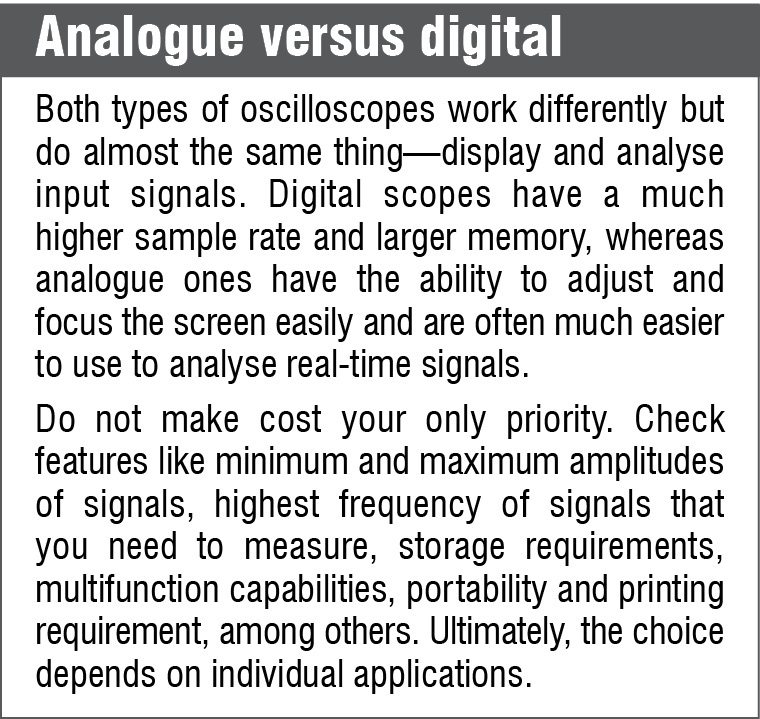 observe electrical signal waveforms such as amplitude, frequency, distortion and time intervals. Broadly, there are two types of oscilloscopes: analogue and digital.
observe electrical signal waveforms such as amplitude, frequency, distortion and time intervals. Broadly, there are two types of oscilloscopes: analogue and digital.
One key difference between an analogue scope and a digital one is that the former uses a cathode ray tube. As compared to the digital variant, an analogue scope is generally less expensive. You can get an analogue scope that provides adequate performance and functions for use in many laboratories and service stations.
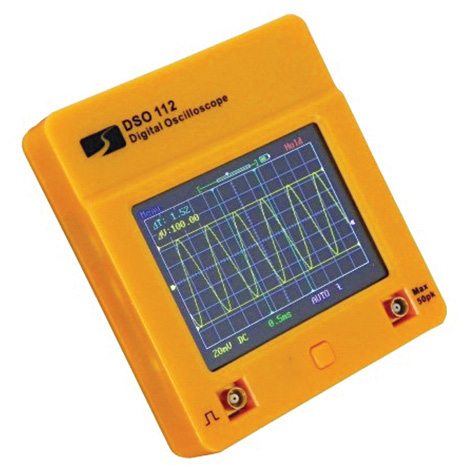
Budget-friendly oscilloscopes, generally speaking, are general-purpose entry-level oscilloscopes with good price-performance ratio. Such scopes are now becoming popular among hobbyists, students and experimenters. These are available in various form factors such as traditional benchtop, handheld, pocket and PC based. A few of these are handy instruments that you can easily carry in your toolbox or bag.
Currently, low-cost pocket-size oscilloscopes are mostly designed and manufactured in China, but are readily available on eBay and Amazon. A typical pocket-size oscilloscope is shown in Fig. 1 and a handheld oscilloscope in Fig. 2.
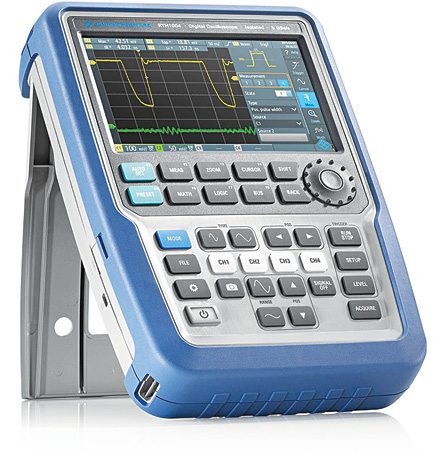
A PC based oscilloscope becomes a handy tool because you can observe the waveforms, like on any other oscilloscope, on your computer screen. Of course, it requires a specialised signal-acquisition board that normally uses a microcontroller or processor. The board is interfaced with a computer using an external USB or an internal add-on PCI or ISA card. The user interface and signal-processing software runs on the PC rather than on an embedded system, as in the case of a conventional scope.
A PC based oscilloscope is available at a much lower cost as compared to a conventional oscilloscope and is ideal for students. A typical PC based oscilloscope is shown in Fig. 3. Some commonly-available PC based oscilloscopes are listed in Table I.
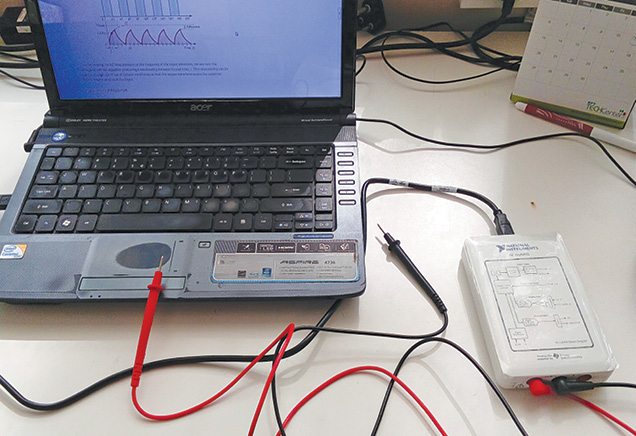
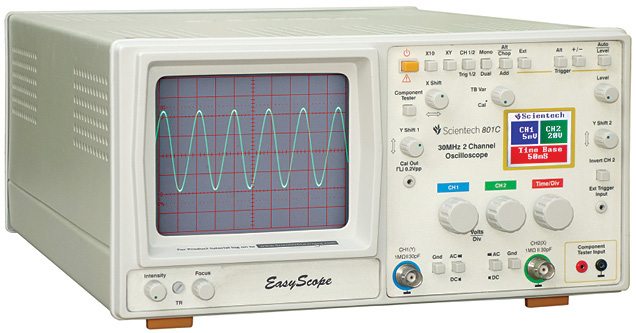
Many high-bandwidth oscilloscopes have wide applications but cost much higher. However, high bandwidth is not always required. Some medium-range bandwidth (15MHz-100MHz) oscilloscopes are available for less than US$ 300 as budget-friendly oscilloscopes from various sources.
There are some oscilloscopes having rich features but are 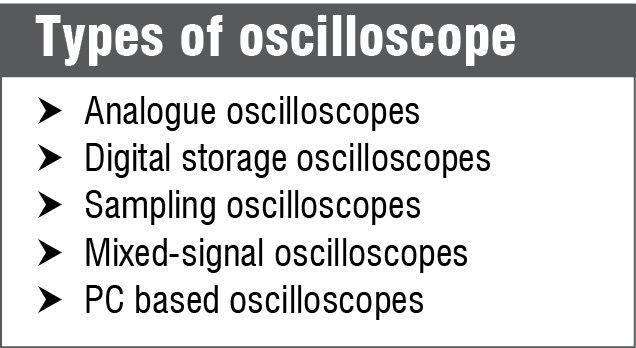 available for just over US$ 300. For example, a budget-friendly analogue oscilloscope such as the one shown in Fig. 4 is a modern 30MHz digital readout oscilloscope with built-in component tester, computer interface (option), colour LCD readout and other built-in options (at extra cost) like function generator, curve tracer, logicscope, power supply, frequency counter or digital voltmeter.
available for just over US$ 300. For example, a budget-friendly analogue oscilloscope such as the one shown in Fig. 4 is a modern 30MHz digital readout oscilloscope with built-in component tester, computer interface (option), colour LCD readout and other built-in options (at extra cost) like function generator, curve tracer, logicscope, power supply, frequency counter or digital voltmeter.
Amidst a plethora of brands and specifications available in the market, and with a limited budget, getting the right oscilloscope is a daunting task. Let us explore some important aspects in low-cost, budget-friendly oscilloscopes.
Features to look for in an Oscilloscope
“Budget-friendly oscilloscopes are basic scopes with limited functionalities and performances for very cost-conscious customers. These scopes have no rich features but can be used for simple testing and measurement,” says April Fang, sales manager, Siglent Technologies Co. Ltd, Shenzhen. While this is true, it is always good to look out for better options that meet your exact requirement at minimal cost.
There are many vendors supplying low-cost oscilloscopes that have more functions and upgradable features. “In budget-friendly scopes one has to look for good performance combined with functionality, form factor and battery operation. Performance includes higher sampling rate with larger memory to provide better analysis of the signals. A higher waveform-acquisition rate enables faster capture of faults to reduce debug time. The product has to offer upgradable bandwidth and serial protocol decoding features to cater to future requirements of the customer to provide investment protection,” says Srinivasa Appalla, manager – product support and application, Rohde & Schwarz India Pvt Ltd.
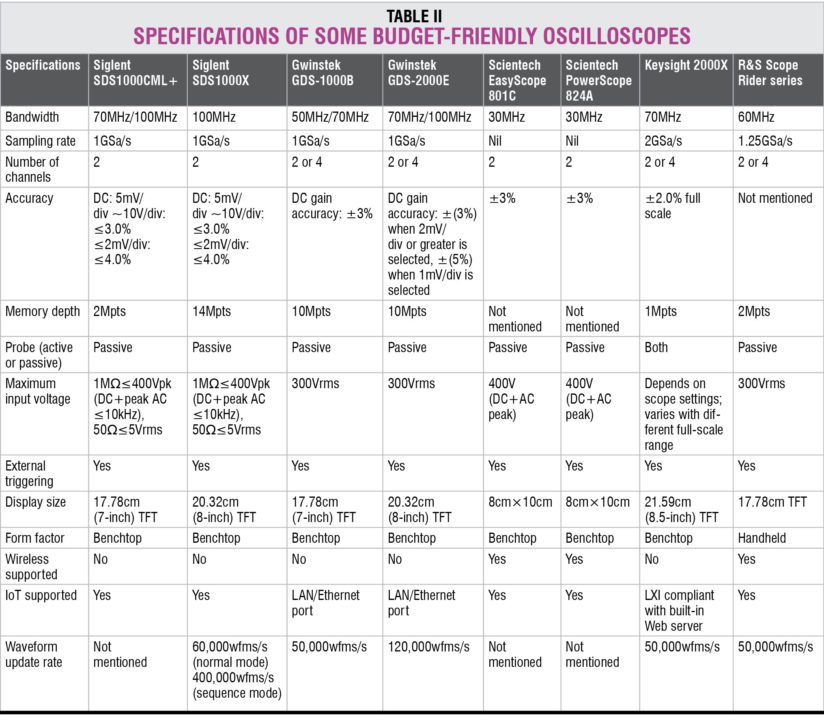
Most budget-friendly oscilloscopes are available with sample rate less than or equal to 1GSa/s, bandwidth below 200MHz, 8-bit analogue-to-digital converter, low-waveform capture rate, basic trigger controls, auto measurement and basic mathematical functions for waveform.
With your budget in mind, you should always go for a higher waveform-acquisition rate for faster capture of intermittent or infrequent events like sporadic interference in clock signals. Troubleshooting in the field often requires a variety of functions. The more the functions in an instrument, the less the number of additional instruments required.
“While selecting a budget-friendly oscilloscope one should always keep in mind that the selected oscilloscope should not compromise on signal capture and display. This is important because the primary purpose of an oscilloscope is to capture the signal of interest with the highest possible fidelity,” says Akash Srivastava, application engineer, Keysight Technologies, India.
Some features and specifications you might expect in a scope are given below.
Bandwidth. Bandwidth is one of the most important specifications in an oscilloscope. It specifies the range of frequencies it can reliably measure. Response of the scope will drop off rapidly as the input frequency is raised beyond the specified bandwidth. As a rule of thumb, your scope’s bandwidth should be at least five times higher than the fastest digital clock rate in your system under test.
Sampling rate. Sampling defines the number of times a signal is read per second. The faster you sample, the lesser information is lost and the better the scope will represent the waveform or signal on display. It is similar to the frame rate of a movie camera. Sampling rate determines how much waveform detail the scope can capture. But it has some limitations because the faster the sampling rate you have, the faster your memory will be consumed. Therefore a higher sampling rate demands a large memory depth. Scopes with sample rate up to 1GSa/s are easily available in the market.
Memory depth. If you are using the oscilloscope to analyse digital signals, memory depth is extremely important. The larger the memory, the better the scope will capture the signal. However, if the CPU is not capable of handling deep memory records, the process will become slow, lowering the update rate of the scope. Therefore choosing the right memory depth and CPU speed is important. Memory depths of 2Mpts to 14Mpts per channel are available in the market.
Channels. Two or more channel scopes are very common these days. These allow users to read more than one signal at a time, displaying all of these on the screen simultaneously. Each signal read by a scope is fed into a separate channel input.
Accuracy. Mostly accuracy specifications given in the manual are related to vertical DC accuracy. For example, DC accuracy of ±3% at 5mV/div is common among budget-friendly oscilloscopes. Due to various design and manufacturing challenges, it is generally not practical for a manufacturer to guarantee AC accuracy better than ±3dB.
Probe (active or passive). You can call it test lead or test prod or, simply, a probe. We often forget or overlook the importance of the probe while using an oscilloscope. You should select an oscilloscope probe that faithfully transmits the signal from your device under test to the oscilloscope.
Broadly, probes are of two types: active and passive. An active scope probe uses a high-impedance, high-frequency amplifier mounted in the probe head and a screened lead. A passive scope probe contains no active electronic part and therefore requires no external power. A typical passive probe uses a mega-ohm series resistor shunted by a low-value capacitor to make an RC-compensated divider with cable capacitance and scope input. As a rule of thumb, for a general-purpose oscilloscope with less than 500MHz measurements, a high-impedance passive probe is a good choice.
Attenuation refers to the output signal’s ratio to the input signal with respect to voltage. Usual oscilloscope probe attenuation levels are 10 and 1 (1 for no attenuation). The 10x scope probe uses a 9-mega-ohm series resistor to provide 10:1 attenuation.
Maximum input voltage. Every electronic device has its limits when it comes to high voltage. If your signal exceeds maximum rated voltage, there is a good chance the scope will get damaged. Most general-purpose oscilloscopes have maximum AC voltage ratings up to 400V and DC ratings up to 300V.
Waveform update rate. It is an important specification in oscilloscopes, which is expressed as waveforms per second (wfms/s). Higher waveform update rates provide better visual insight into signal behaviour.
Oscilloscopes have an inherent dead-time between each waveform acquisition. During the dead-time, any signal activity that may be occurring will be missed. Capturing random and infrequent events becomes a matter of probability, like rolling the dice. The higher the probability of capturing, the better the scope will display the results. Oscilloscopes with 50,000wfms/s or higher are easily available in the market.
External trigger. This is not used often but is sometimes very useful. The trigger controls let you stabilise repeating waveforms and capture single-shot waveforms. The trigger makes repeating waveforms appear static on the oscilloscope display.
Display size. Display size always matters as we see signal waveforms on the oscilloscope’s screen. A bigger screen display is always more comfortable to watch and work with. There are traditional cathode ray tubes, thin-film-transistor liquid-crystal displays with touchscreen display, flexible display and so on.
Form factor. Oscilloscopes may be divided into three categories depending on size and shape: benchtop, handheld and PC based.
A benchtop oscilloscope is aimed at having the highest performance. Almost all functionalities are available in this category. Handheld is portable and hence advantageous for the user on the move, but display quality and performance may be poor as compared to benchtop.
A PC based oscilloscope is becoming popular because PCs and laptops are easily available at home or workplace. You just need a portable external hardware or a dedicated add-on card in your PC along with suitable software.
Wireless supported. Wireless oscilloscopes support Bluetooth and Wi-Fi interface. The oscilloscope uses Wi-Fi module to create its own WLAN hotspot. Measurements can be done using the Web browser on a notebook, tablet or mobile phone.
With wireless, the PC becomes a virtual oscilloscope and can be used in special situations such as monitoring the signal while on the move or life-risky environment like in nuclear stations. But most wireless oscilloscopes have limited bandwidth.
IoT supported. Scopes having built-in wireless LAN module or Wi-Fi module act as hotspots. Some oscilloscopes have dedicated Ethernet ports for connecting to the Internet. Measurements can be monitored remotely using the Web browser on tablets, smartphones or PCs. The Internet of Things (IoT) capability on the scope allows measurements on high-voltage environments and brings safety to users.
Industrial automation, education management, remote test and measurement and some other functions need IoT oscilloscopes.
Technical specifications of some budget-friendly oscilloscopes are listed in Table II.
New trends in Oscilloscopes
In recent years, we have seen many changes in budget-friendly oscilloscopes. We see many innovations with added features in today’s oscilloscope like better performances including higher capture rate and CPU performance, features such as smart trigger and decoding, and mixed-signal oscilloscopes and arbitrary waveform generators.
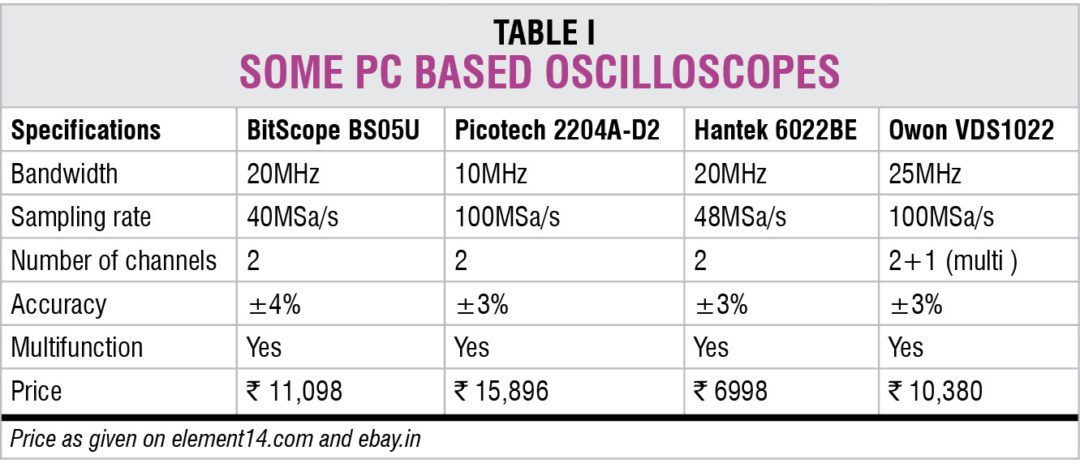
Technological advancement in analogue-to-digital converters has resulted in high vertical resolution scopes that give better measurement accuracy.
Apart from wireless and IoT features, the latest scopes are enhanced with logic analysers, spectrum analysers, digital voltmeters, protocol analysers, counters and so on.
In the future we could see smarter and virtual oscilloscopes with even more features at much lower cost.
To conclude, if you are planning to buy a budget-friendly oscilloscope, first check your requirement, search the Internet for options and see if you can find a value-for-money oscilloscope. But keep in mind that you should never compromise on bandwidth, signal capture rate and display.
Explore our other technical buyer’s guides
Sani Theo is senior assistant editor – tech at EFY







I very recently purchased a DS203, (also referred to as a DSO203 or DSO Quad), Analog/Digital scope for hobby-experimental use. I’m new to scopes, so I expected some degree of a learning curve.
First, it is a very nice looking device and comes with some connectors and a carry bag.
Second, this scope comes with absolutely no printed documentation. Instead, it comes with a mini-CD which contains several folders which contain various files, but, no clear instructions as to how to operate the device or simple analog examples, such as testing an analog signal.
You are given a very brief, difficult to understand instruction about loading the operating system from the disc and a link for more recent updates.
Apparently, it is quite easy to “brick”, (crash, make unusable), the device during the software update process, because much of the discussion on the forum at the provided link concerns that topic.
It appears that this device is entirely user supported with no real instructions, tutorials or documentation from the manufacturer.
I’ve spent several hours trying to figure out this device and I’m still at square one !
I can’t seem to get it to display a simple audio signal I provide it. It leaves me wondering if it’s Me, if its really that hard, or if its just broken…
I googled DS203 to see what I could find, in the way of instruction or help, but, there isn’t much of anything.
There is one app, written by a user, that looks like it is supposed to take an audio input and display it, but, it doesn’t seem to work, at all.
There is a calibration function, but, I can’t figure out how it works. There are no hints.
For a beginner, this scope is not for you.
If you have one of these scopes and have figured out how to use it, I’d like to hear from you, as I’m at the point where I’m ready to send this thing back and buy a “Real” analog scope.
How to find prices of product and contact of seller